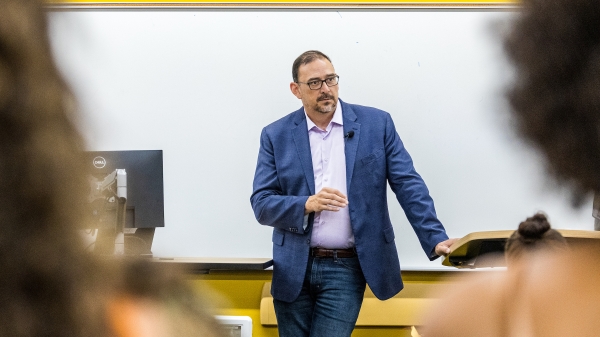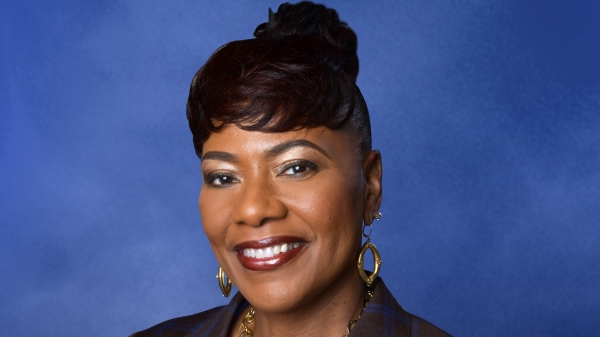President Joe Biden’s proposed American Families Plan would spend $1.8 trillion on several programs, including universal preschool education and funding for child care.
Currently, working families with children under age 5 spend about 10% of their income on child care, according to an analysis of U.S. Census data by the Center for American Progress think tank. The American Families Plan proposes $225 billion on subsidies to ensure that low- and middle-income families spend no more than 7% of their income on child care.
An Arizona State University professor who researches child care policy believes that funding child care is vital for the country’s economic recovery from the short but deep pandemic recession.
“The recession has been disproportionately brutal to working women, and in particular, women with preschool and school-age children,” said Chris Herbst, an associate professor in the School of Public Affairs and a faculty affiliate in the School of Social Work in the Watts College of Public Service and Community Solutions. He researches early childhood education, child care and the impact of policies and markets on child, parental and family well-being.
“It has drawn into sharp focus just how critical child care is for the ability of modern families to function and in particular the ability of mothers to have access to the labor market. If you shut down child care, you shut down the ability to access the labor market, and you’re basically removing about half the family income,” he said.
Herbst answered some questions about child care policy from ASU News.
Question: Why is the American Families Plan important?
Answer: I think of child care as the market that needs to be functioning well if the rest of the economy is going to function well. When the labor force is 50% female and to a large degree made up of parents, men and women, it’s necessary for the government to make it easy for parents to work.
We in the U.S. don’t have much of a child care system to speak of. We have a patchwork of child care providers and policies, none of which works well for providers or families.
Child care can be very expensive for families, of low quality for kids and not all that well paid for providers.
The current plan would get us to where most other countries are.
Q: How has the pandemic affected the child care market?
A: Right now, my colleagues and I are really focused like a laser on studying the impact of the pandemic and the recession on the child care market and families’ experiences and interactions with the child care market.
The pandemic has changed all of our views on child care, not just for basic family functioning, but for the economy. The pandemic recession really laid bare and exacerbated many of the problems that predated the recession.
No one gets into child care because it’s lucrative. Child care teachers don’t make a lot and the providers run on very thin profit margins. Even if a small number of kids drop out, it can put the providers on thin ice.
Through the various lockdowns, the pandemic really emptied kids from child care programs and as a result, the county lost a pretty big share of its programs. Many closed and they’re not coming back.
And now that we’re in a recovery, the question in my mind is, “Would the job growth have been greater if the child care system had been stronger?”
The Great Recession hurt male employment more than female employment. The pandemic recession hurt female employment more than men’s employment. Even though employment has come back, the rates among women have a long way to go to previous levels.
We have had a discussion as a society about this. If you care about economic growth, and equal access to the labor market and the proper functioning of families, you ought to be an advocate for a healthy child care system.
Q: Can you describe your research into the only time that the U.S. has had universal child care?
A: I stumbled upon this little-known child care program that the federal government ran during World War II.
During the early stages of the war, the government encouraged women without kids to enter the labor market to help build tanks and everything else that was needed.
What quickly became clear is that there were not enough childless women to fully prepare the nation for war. There was a lot of reluctance to allow women, and particularly women with young children, to enter the labor market, but it became overwhelmingly clear that women with children were needed.
So the federal government, for the first time, created what was essentially a universal and nearly fully subsidized child care program to look after kids in child care centers while the moms, the Rosie the Riveters, went to work.
The program was universal in the sense that it was open to low-income and high-income kids, no matter where they lived, rural or urban, and irrespective of whether the mothers were working, although in most cases they were.
I was curious to see whether the initial skepticism around this program — and the skepticism was political and also societal — held throughout the war and after.
What was interesting was that some of the biggest skeptics were the mothers themselves whose kids were in child care.
Q: What did you discover?
A: I found surveys of mothers that were given as they were leaving the program. They were essentially customer-satisfaction surveys. They found, basically, 100% customer satisfaction.
The other thing I looked at was what happened to the kids. I was interested not just in their short-run outcomes but whether they were they better off as adults. That’s really the big question for those studying the impact of child care and early childhood interventions.
I found adults in census data who were likely participating in these child-care programs and I compared those folks to individuals who, because of age and location, were not participating in the programs.
I found that the adults who were participating in these World War II child care programs, throughout their 20s, 30s, 40s and 50s, were more likely to be employed, and were earning much more than their counterparts who did not participate. They were less likely to receive assistance. They were in better self-reported health.
Literally, with outcome after outcome, this program seemed to have a positive impact on the adult lives of the participants.
As it turned out, the more I learned about the program, it wasn’t surprising because even though it had to be operable really fast, it was of very high quality. It employed professional teachers, paid them well, delivered health and social services to the kids, and healthy meals. They did academic work with the older kids. There are cute pictures online you can find of kids painting and looking happy.
The federal government was really investing in human capital.
Q: What were the longer term effects?
A: Some economists and economic historians point to World War II as a watershed moment for women’s employment.
The program dramatically changed views about the role of women in the labor market and the potential for government-funded child care to allow women equal access to the labor market.
Those women had kids and those kids grew up seeing their moms work.
What started as a social experiment during the war had intergenerational effects.
Q: It sounds like it was a successful program. What happened?
A: In 1971, a bill was placed on the desk of President Richard Nixon that would have created a system of universal child care. It passed in a bipartisan way through the House and Senate.
Richard Nixon vetoed that bill, in large part because of a push around some scare tactics that focused on, “If the U.S. were to pass universal child care, it would lead to the ‘Sovietization’ of America’s kids. The Soviet Union famously had a very good system of universal child care. Some latched on to this idea that if the government were to assume the responsibility of what was thought to be a private responsibility, a family responsibility to look after kids, it would lead to government control of kids.
This created quite a scare within the Nixon administration and among folks around him.
Some people think of that veto by Nixon as basically ending the conversation on the possibility of universal child care until now. We’re closer to getting a quasi-universal system of child care now because of this legislation put forth by President Biden.
Top image courtesy of Pixabay.com
More Law, journalism and politics

Arizona secretary of state encourages students to vote
Arizona Secretary of State Adrian Fontes looked right and left, taking in the more than 100 students who gathered to hear him speak in room 103 of Wilson Hall.He then told the students in the Intro…

Peace advocate Bernice A. King to speak at ASU in October
Bernice A. King is committed to creating a more peaceful, just and humane world through nonviolent social change.“We cannot afford as normal the presence of injustice, inhumanity and violence,…

CNN’s Wolf Blitzer to receive 41st Walter Cronkite Award for Excellence in Journalism
Wolf Blitzer, the longtime CNN journalist and anchor of “The Situation Room With Wolf Blitzer,” will accept the 41st Walter Cronkite Award for Excellence in Journalism, Arizona State University has…
